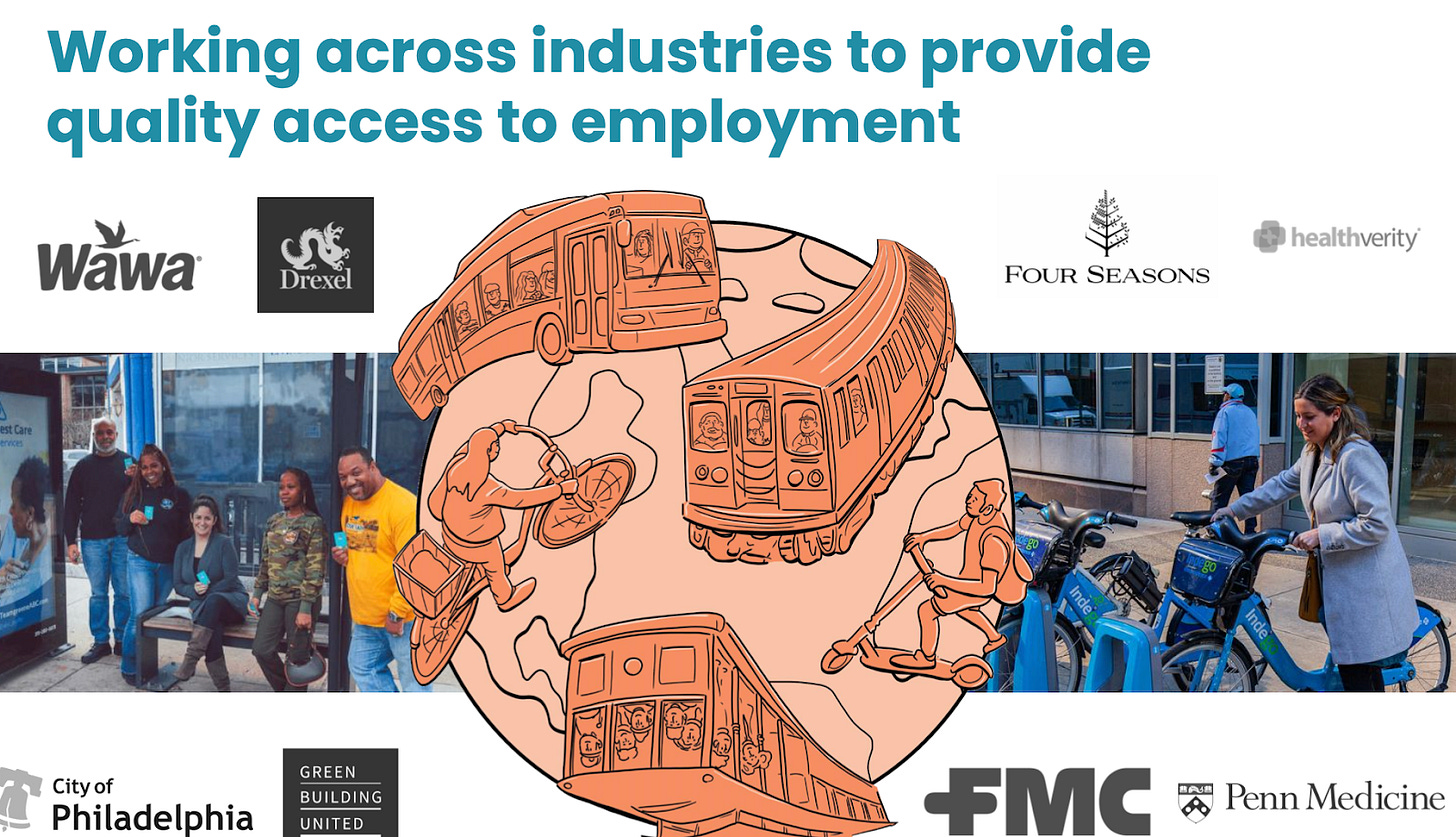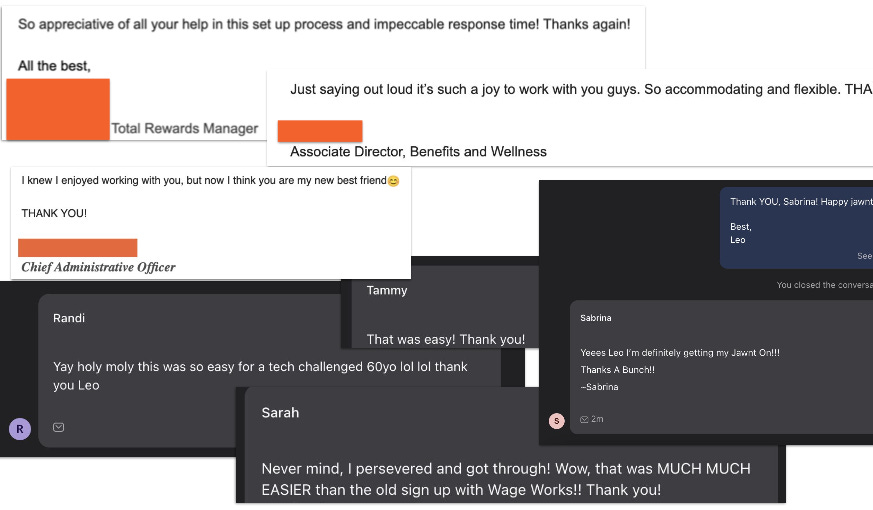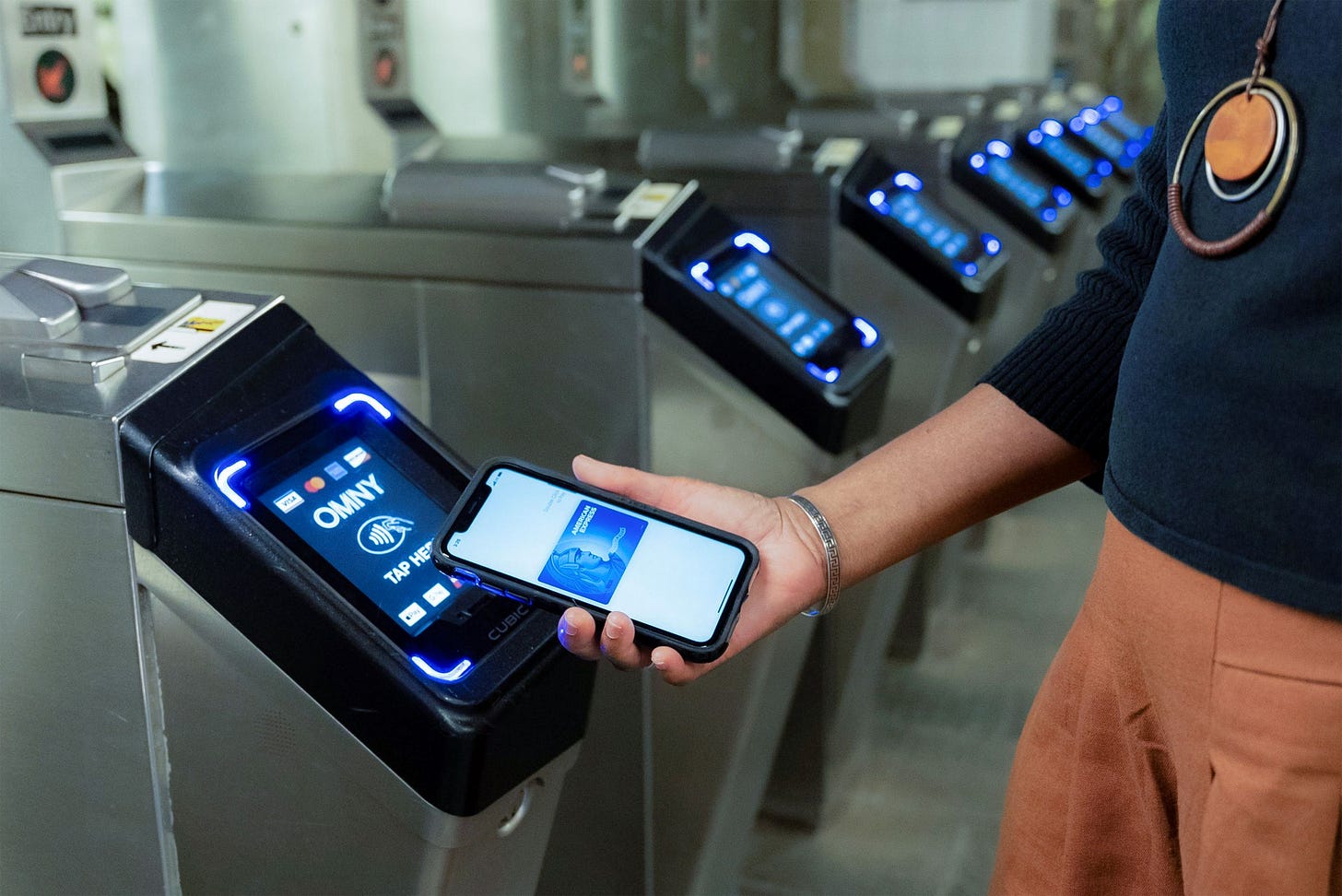Welcome to the 24 who entered The Physicality since the last edition! Join the 647 of those who are into learning about the real world here:
I am in mourning.
I am mourning the era of my venture-capital-subsidized lifestyle. As a millennial, I never have much going for me. Born too early to ever achieve economic parity with my parents. Born too late to not be instantly cringe on the internet. But at least I had tasted the sweet nectar of $7 Ubers, free meal kits in rotation, and 45% off food delivery. Alas, even that party is over.
Who is going to subsidize our lifestyle now? The same entities that always have: our employers and our government. As companies care less about getting canceled and demand workers “RTO”, millions of us need to assess our commute in a way we haven’t needed to for a while. As we do, we may find that our options are in a weird place. Dockless scooters got decked by the government. Bikeshare is entering certain markets and leaving others. Rideshare and subway prices have gone up. It’s just a mess.
Luckily, a promising startup out of Philadelphia has emerged to make it easier for employers, governments, and transit agencies to do right by each other. Co-founders Jeff and Will sat down with me to explain why Jawnt may soon be one of the most used cards in our mobile wallet. Before we get into the details, let’s take a jaunt through the mobility transition.
Today’s Ride:
The Funky Mobility Transition
Jawnt: The Punniest Transit Pass
Every Rider’s Every Trip: Introducing the Jawnt Pass
Unusual Growth Strategy
What a Time, To be a Transit Pass
We Need to Save Public Transit
The Funky Mobility Transition
Venture capital fueled dozens of new transportation models in the last ~15 years. Led by Uber and Lyft in the early 2010s, a fleet of ridesharing companies flooded our streets. Shortly after, that model was extended to “vanpools” like Via and Chariot. Since that wave, bike share, mopeds, and scooters were mixed in, to mixed results.
VCs subsidized our travel in hopes of changing consumer behavior. In many ways, mission accomplished. We have come to rely on rideshare as we rely on heat, water, and gas. However, not all of these experiments were smooth rides. After once being valued at $2.5B, Silicon Valley darling Bird crashed along with broader investor appetite for micromobility. Crippling maintenance costs and that darn pandemic were two stones that took many birds. Dozens of 2, 3, and 4-wheeled options, some of which we adored, flattened globally.
The mobility ecosystem is changing tact in response. Providers are now collaborating with the government instead of trying to piss them off. For example:
Uber added taxis and public transit to their apps. They are molding their models to work within a country’s regulations instead of trying to skirt them.
Joby, the electric air taxi company, didn’t just plop their electric vehicles into the middle of Manhattan. They built trust with the city over a decade to ensure they took off on the right…propeller? That hard work only now seems to be paying off with recent test flights in the city.
Via jettisoned its private vanpool service and is now a transit tech company. In certain markets, they offer Via’s vans to better connect the city’s public transit apparatus. They are also behind the “CityMapper” app, which is leagues above Google Maps and offers “transportation planning and scheduling software” to transit agencies.
This transition from antagonistic to cooperative has its growing pains. Let’s take NYC’s Citi Bike as an example. I, and thousands of others, would consider bike share critical transit infrastructure. Given how important it is, it astounded me that Citi Bike is neither owned by the city nor by Citi. LYFT owns it. Yes, pink mustache is the biggest operator of bikes in the country, controlling the bike share in metropolises like Chicago, SF, and Washington D.C. This near-monopolistic stranglehold on bike share operations nationwide has been a double-edged sword. When Lyft doesn’t want to be in that market anymore, they have carte blanche to cart out of there like they did in Minneapolis and Santa Monica. This leaves people stranded.
Given this volatility, governments have had to change tactics. Cities like Boston own the bikes while Lyft remains the operator. Pittsburgh’s bikeshare is a nonprofit and Austin’s is part of the public-transit system. Experiments are aplenty. Transit agencies, governments, and mobility enterprises are all figuring out the right model. Jawnt is in the middle of all of the action.
Jawnt: The Punniest Transit Pass
Jawnt. Yes, a play on “jaunt” and Philly slang, “jawn”. No, I won’t explain it. You just have to feel it. More than a pun, Jawnt is a marketplace connecting organizations and mobility providers – including transit agencies. Yet, they moonlight as a “commuter benefits” program.
Every year, HR teams go hunting for health insurance, 401k providers, and sometimes, commuter benefits. In New York City, we can sign up for an MTA program that lets us pay for unlimited subway rides through our paycheck, before taxes. While subways are great, the MTA commuter pass feels limited in a world filled with other mobility options.
So, Jawnt extends commuter benefits to more than just subways. They aggregated bikeshares, carshares, scooters, buses, and even Amtrak. If you have to return to the office, Jawnt is making it possible for your employer to subsidize more of your daily commute. This is an opportune time for Jawnt to be in market as we are expecting employers to pay for our transit.
And employers are paying. The University of Pennsylvania uses Jawnt to offer a 50% subsidy on the following transit systems:
When MIT offered their 10,000 staff members a fully subsidized transit pass, it led to an “eight percent reduction in parking demand in the first year. Transit agency revenue increased rose approximately ten percent." Subsidizing employee travel was a win-win for the university and the city.
Commuter benefits are not just a logical employee perk, they may also have a material impact on a company’s bottom line. A hospital system Jawnt works with had a parking crunch. Each spot used by a hospital employee took one away from a patient. It got so bad patients had to wait in line to get into the hospital. In some cases, patients just peaced out. Peaced out patients means no money. This hospital partnered with Jawnt to provide employees with more transit options, which freed up spaces for patients and revenue.
Jawnt, of course, is just the marketplace. Employers’ decision as to how much they subsidize is up to them entirely. Through the companies they’ve worked with, Jawnt concluded that the more of an employer subsidy there is, the greater the employee participation. Interestingly, smaller companies tend to fully subsidize more frequently than larger ones, who opt for a 50%-ish subsidy. With this major Jawnt update out today, we may start to see larger companies subsidize even more.
Every Rider’s Every Trip: Introducing the Jawnt Pass
Jawnt’s mission is to be a part of “every rider’s every trip.” To do that, they needed to get inside the payment flow. Today, the day of publishing, Jawnt has launched its official “Jawnt Pass”. It’s a first-of-its-kind debit card that can be used for pre-tax commuter benefits… anywhere. Your employer doesn’t need to be partnered with a specific transit agency for them to subsidize your travel anymore. Instead, they can carve out a portion of your paycheck for you to use on qualified transit, anywhere.
Here is Jawnt Co-Founder Will doing the very first Jawnt Pass swipe on a bus:
While this debit card is huge on its own, it's even huger that the Jawnt Pass is live on both Apple Wallet and Google Pay from day one. Even though we have ubiquitous tap-to-pay infrastructure with OMNY, NYC City Employees still can’t use their commuter card benefits with their phone because legacy providers still don’t support the 21st century. With Jawnt, you can now tap-to-pay pre-tax commuter benefits. This means pervasive coverage for transit expenses. While this may seem simple enough, Jawnt is the first commuter benefits program to allow this.
Like other benefits programs, Jawnt charges the employer based on headcount. They charge per employee per month. In their first market of Philadelphia alone, they just surpassed 100,000 members. With the playbook written, they are ready to move out.
Unusual Growth Strategy
It’s not just that Jawnt has 100,000 members, it’s the caliber of members. A company that started in the early days of the pandemic earned the adoration of universities, hospitals, large corporations, and scrappy startups in short order. Jawnt attributes its success in Philadelphia to being a “good steward of transportation”. Their playbook is simple, yet effective:
Build trust with the local transit agency. Listen to them. Understand them. In Philly’s case, it was SEPTA.
Use the transit agency’s buy-in as substantiation to earn the trust of the biggest employers and public programs in the city. UPenn, Drexel, Wawa, etc.
Customers refer Jawnt to other customers.
Trickle down from there, working with smaller entities
Jawnt plans to bring that same deep and methodical expansion plan wherever they go next. CEO Jeff Stade writes in an email to his employees,
“At 10X scale, Jawnt is still concentrated in a handful of large markets. We already have seen how well it worked in Philly to do deep work in this market. Our customers appreciate how well we know the city. The transit agency refers us to customers. Customers refer us to other customers. It’s less operationally complex.”
As someone who has seen a lot of early-stage growth strategies, the “slow and methodical” one is rare. The traditional worry with this approach is that once people see how well Jawnt is doing in Philly, they will rush to replicate it elsewhere.
Jeff and Will aren't worried. They know how difficult it is to be a trusted steward of transit. Their partnership with SEPTA has opened up promising conversations with transit agencies nationwide. Jawnt is setting the standard for a public-private partnership that they feel will be difficult to replicate.
Given their starting position in Philadelphia, their biggest customers so far are hospitals and universities. But really, Jawnt can work with any company that wants to provide transit benefits. They personally think that employers with campuses, companies who want to reduce parking demand, and/or rely on shift-based workers are the best fits for Jawnt.
For an example of the latter, Jawnt helps Physicality favorite Wawa offer their shift workers the option to put more of their pay towards pre-tax commuter benefits. Beyond these groups, Jawnt can be used to support subsidizing students, seniors, and low-income use cases. They currently work with Philadelphia’s Zero-Fare Program to offer low-income residents subsidized transit passes.
Next up are cities that feel like Philadelphia from a transit perspective – where local transit is needed yet the transit agency is struggling to grow ridership. They’ve identified target markets to be places like Seattle, Portland, Chicago, and Boston. If someone knows Mayor Eric Adams, please send this piece to him! NYC needs Jawnt.
You may be asking, why has it taken so long to develop a commuter pass with dozens of mobility options? Why was our existing commuter pass not on our phone? Why is Jawnt working now? Timing.
What a Time, To be a Transit Pass
This is a case where a startup wouldn’t have worked out as well just a few years ago. In “Why Startup Timing is Everything”, NFX Partner Pete Flint writes,
“Enter a market too early, no matter how strong the founding team, and you could be stuck waiting for a day that never comes. Enter too late and you’re fighting an uphill battle against incumbents with greater scale. In startups, timing is everything.”
Flint lays out three pre-conditions for the right time to start something: Economic Impetus, Culture Acceptance, and Enabling Technologies. I’ll explain each and map that to Jawnt:
Economic impetus, or when providing a product/service shifts from unprofitable to profitable. This usually happens when either something cheap becomes expensive (education) or when something expensive becomes cheap (bandwidth).
In Jawnt’s case, it was that all forms of mobility, but most importantly subways, have risen in price. Ridership has declined since 2015 and is only got worse during to the pandy. An APTA May 2023 survey pegged national ridership at only 72% of pre-COVID levels. Fewer riders means less revenue. Less revenue means lower quality transit. Lower-quality transit means fewer riders. And so on. It’s a vicious cycle. Transit agencies are facing a “fiscal crisis.” By 2026, Chicago’s RTA expects to be in a $730M deficit. LA Metro expects to be in a $1B hole in the same frame. For us customers to use public transit more, we need the support of governments and our employers to do that. Jawnt enables them to do that.
Cultural acceptance, or a change in consumer behavior that makes the product/service viable (TikToking in public).
The culture change here is “necessity”. Mobility providers like Uber now want to work with governments instead of fighting them. Corporations need to incentivize workers back in the office. Governments need to work with other mobility providers and technology companies like Jawnt for the good of the city.
With the RTO push, businesses and transit agencies in particular need each other in a way they never did before. Transit agencies are catching on that this is a unique opportunity to sell to corporations. SEPTA, the subway systems in Philadelphia, and surrounding neighborhoods are pushing a corporate commuter pass program. It’s wild to see my hometown transit system get into B2B sales. Each group has their own struggle that will be eased by the other. Jawnt is making this newfound partnership more feasible for everyone involved.
Enabling Technologies, or underlying pieces of technology that allow your product/service to be used by customers at scale. For example, social media wouldn’t be useful without cell phones.
In Jawnt’s case, commuter benefits wouldn’t have been nearly as useful without contactless payment. The advent of one-tap-pay technology infrastructure in subways, like OMNY, along with OTP tech on every rider’s phone is critical for Jawnt’s success.
We Need to Save Public Transit
Public transit is the lifeblood of a city. Its health represents the city’s health. It is one of the rare aspects of our life that doesn’t treat you differently based on how much you can pay. It's 10 times safer per mile than a car. It saves 6 billion gallons of gasoline annually. But as we covered before, it’s in a tough spot. Ridership and revenue are in the tanker. Other mobility options like bike share and scooters are struggling as well.
Jawnt is helping transit agencies and employers make non-car mobility a viable option. They are:
Creating a mobile-first commuter pass to bring the public transit experience to the modern era
Bringing more mobility options to the marketplace to reflect our existing consumer behavior and
Making it easier for employers to subsidize transit
All three of these are significant quality-of-life improvements for us. The team makes it clear that commuter benefits are just step one. Jawnt aspires to become a holistic transit intelligence platform for employers. They want to help corporations decide which mobility options to provide employees, how to broaden corporate travel beyond cars, and even influence parking. It’s important work. Jeff writes to me, “If we can keep even one organization from having to build a new parking garage, I will die happy.”
If you’re an employer, request a demo for Jawnt here.
Keep it real,
Safi
Thank you for reading! Thank you to Julianna for editing. Thank you to Sakib for the introduction to the Jawnt team.
According to my calculations, about 25% of you work for yourself. Like me! We have so much in common. So, that’s why I gotta share Carry’s financial products built just for us entrepreneurs. We don’t need to go corporate for 401Ks and Roth IRAs now! Check it out here.
What’s next?
Invites to Joust are out. If you’re into playing board games with interesting people in beautiful locales, make sure to sign up here.
If you liked this piece, check out the greatest mobility hits: Uber, Shinkansen, Joby.
Subscribers sharing on socials has proven to be the best way for this newsletter to grow. I would greatly appreciate it <3



















